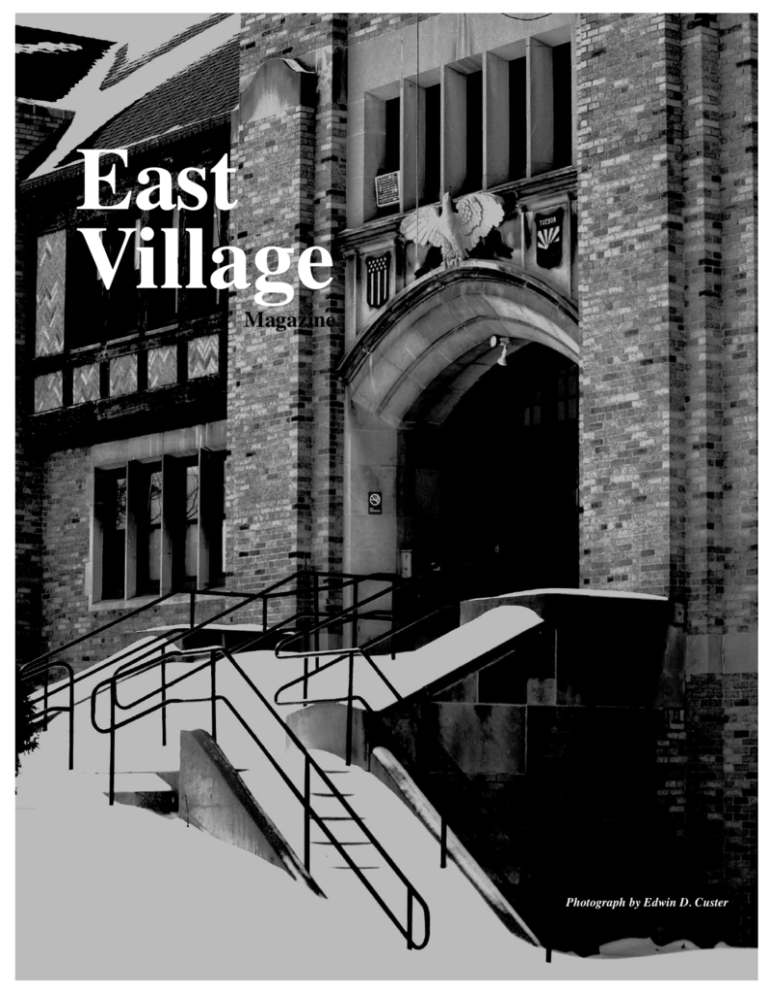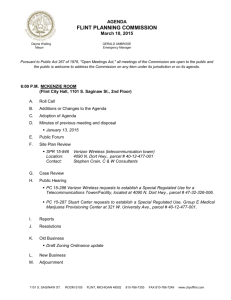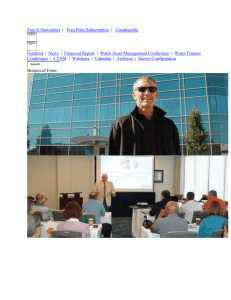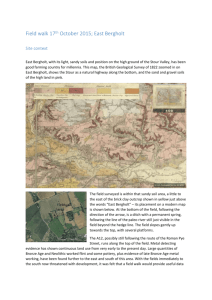March 2015 - East Village Magazine
advertisement

East Village Magazine Photograph by Edwin D. Custer Music at St. Paul’s South Saginaw at Third Street Artistic Director G. Donald Kaye Presents Jeffrey Walker piano The keyboard artist’s man for all seasons 3:30 p.m. March 15 Pia Broden Williams soprano A jewel in the crown of our regional vocal scene 3:30 p.m. April 26 Friends of Music or $10 & $5 (student) (810) 569-1545 Free instruction in the original Biblical languages of Arabic, Aramaic, Greek, Hebrew and Latin Contact Unclassified ads kennethharold72@yahoo.com In Christian Love and Prayer, Brother Richard Allinger Associate Degree in Biological Sciences (1973), C.S. Mott Community College; B.A. in Elementary Education (1978); B.R.E. (2012) and M.R.E. Candidate. VERN’S www.unitedtheologicalseminarymonroe.org, www.mtcalvaryflint.com COLLISION INC. Free Loaners • Unibody • Frame • Paint Specialists • Glass • State-certified Mechanics More than 40 years at the same location. (810) 232-6751 2409 Davison Rd. BATTISTE’S TEMPLE DINING ROOM PUBLIC WELCOME Serving Downtown Flint since 1947 Luncheon Monday-Friday 11 a.m. - 2 p.m. All Occasion Catering 235-7760 HELP! East Village Magazine is seeking new volunteer distributors for the area north of Court Street. It takes less than an hour a month, you'll get exercise, and you'll get to meet your neigh- bors! If interested, email Ed Custer, ecuster@sbcglobal.net. 2 Editing Services. Eagle Eye Editing and Proofreading Services provides top-notch copy editing and proofreading for your writing needs by a published author and East Village Magazine copy editor and proofreader. Prices depend on the type of project and number of pages. Contact Danielle E. Ward at www.eagleeyeediting@danielleelyse.com. For Rent. House, 4-bedroom, 11⁄2 baths, laundry, walking distance to UM-Flint and MCC. (810 235-0021) Four Apartments for Lease Below. From all four apartments, walk three blocks or less to UM-Flint and MCC campuses, Cultural Center, downtown, Farmers’ Market, four parks, bike paths. Easy freeway access. References and credit check requested. On-site management. Off-street parking. E-mail ecuster@sbcglobal.net or write Apartment, 720 E. Second St., Flint MI 48503. • Historic and spacious four-bedroom, threestory, East Village apartment near Kearsley Street partially furnished with a full front porch, high ceilings, hardwood floors, fridge, range, dishwasher, 21⁄2 baths and basement laundry. Heat and water included is only $895 a month plus electrical. Pictures available. • Four-bedroom second-floor apartment on Crapo Street just off Kearsley Street. Recently remodeled featuring AC, new appliances, sunroom, smokeless fireplace, hardwood floors, pantry, laundry, garage with automatic door. Can be partially furnished. $725 per month includes water. Pictures available. • Large furnished two-bedroom apartment on East Second Street. Laundry and off-street parking, $585 a month plus heat and electrical. Pictures available. • Three-bedroom townhouse on Avon near Kearsley St. for lease in July. Laundry, appliances, garden plot, $595 per month plus all utilities. East Village Magazine Vol. LIII No. 2 March 2015 Founder Gary Custer Editor Managing Editor Copy Editor Reporters Columnists Éminence Grise Photographer Poets Jan Worth-Nelson Nic Custer Danielle Ward Nic Custer Connor Coyne Andrew Keast Ashley O’Brien Jack Minore Jan Worth-Nelson Teddy Robertson Paul Rozycki Ted Nelson Edwin D. Custer Grayce Scholt Nic Custer Distribution Staff Director: Edwin D. Custer. Staff: Kim Bargy, Jane Bingham, Casey & Nic & Andy Custer, Emma Davis, Andrea Garrett, Charlie & Linda & Patrick & Terrance & Christan & Jillianne Goldsberry, Cyndi Hahn, Robert Jewell, Carol Larzelere Kellermann, Jo Larzelere, Annette LeBlanc, Mary LeRoy, Bill & Carol Leix, Lillian & Livia Londrigan, Alan & Julie Lynch, Annette McCarthy, Ron & Mary Meeker, Robert & Nancy Meszko, John Moliassa, Keith Mullaly, Mike Neithercut, Edith & John Pendell, Dave & Becky Pettengill, Debbie Rumsey, Barbara & Richard Schneider, Mike Spleet, Gina Stoldt and Krista Striler. Board of Trustees • James J. Wascha • George I. Liljeblad • Bella Doebeli 720 E. Second St. Flint, Mich. 48503 (810) 233-7459 Web Site: eastvillagemagazine.org E-mail: eastvillage@sbcglobal.net Typography by Ted Nelson and Jean Shipley. Printing by Riegle Press Inc., 1282 N. Gale Rd., Davison, Mich. 48423. The East Village Magazine is a program of the Village Information Center Inc., a nonprofit corporation. We welcome material from readers, but all submissions become the property of the publication and if published will be edited to conform to the editorial style and policies of the publication. All inquiries about the publication should be mailed to East Village Magazine, Village Information Center, 720 E. Second St., Flint, Mich. 48503. Distribution is the second Saturday of each month. Display advertising rates are $34.50 a column-inch plus any other costs. Unclassified ads are $2.50 a printed line or part of a printed line. Rates subject to change without notice. The deadline for advertising is 10 days before each publication date. Editorial “Survival is insufficient” By Jan Worth-Nelson Williams, Philip Seymour Hoffman, Bob In between bouts of semi-feverish work on Simon … every day new losses, new this issue of East Village Magazine, I’ve been emptiness. reading a new novel called Station Eleven, by But the rest of us are still alive. That is Emily St. John Mandel. It’s a post-apocalyptic a sweetness, even in our grief, is it not? tale and takes place largely in Michigan. In it, For me, taking up the work of East a troupe of Shakespearean actors wander Village Magazine has been a proper devoamong ruined towns in a horse-drawn caravan tion, binding me in new and deeper ways – there are no cars, no phones, no TVs, no to this community, to all of you. So thank electricity – and put on their plays for raggedy you for picking up this black-and-white bands of survivors. gift we offer to your eyes, your heart and And on their wagon is painted the motto, your mind. “Survival is insufficient.” Some of the old In this issue you’ll find an interview with farts remember the line – from a long ago a talented Flint native poet, Sarah Carson, Star Trek episode. Around campfires, they whose new book Buick City will make your piece together the story to tell to the kids heart ache. You’ll read Grayce Scholt’s latwho can’t picture any of it. Trying to grasp est poem about “a little life” and you’ll why they were the survivors and how to get savor Teddy Robertson’s essay about the from one day to the next, the little band enchantments of significant objects. You’ll gradually begins to shape a world beyond read Paul Rozycki’s modest proposal for simply living. what to do with Flint water. And you will I’ve been thinking a lot about that line: read an in-depth account of a neighborhood Survival is insufficient. I don’t know association that is wrestling with change in about your life, but in mine there has been Carriage Town. a lot of death in the air in recent months. We didn’t have room for everything I am thinking of Gary Custer of course, this month. We invite you to go to but also brilliant photographer Valerie e a s t v i l l a g e m a g a z i n e . o rg f o r m u c h Clarke, gifted downtown poet Ryan more good writing and relevant news. Bellows, and widening outward, the poets We hear not everybody is happy with our Philip Levine and Carolyn Kizer, Robin neighborhood coverage. Be aware we are there not just to drily inventory reports. We are there to document the real challenges of neighborhood life. We love and laud those struggles, but we are interested in the “how” as well as the “what.” Humans in transition tend to be a messy, loud and emotional lot. But creativity often flowers from chaos, and we want to be there to see how the buds bust open. So expect to see us there watching They are your neighbors and they with responsible gusto for the hard work underway toward the common good. have been delivering East Village So, fellow survivors, here we are. Some of Magazine as volunteers, even on the you have been through hell. You’ve surabsolute coldest days of the year. vived winter freezes, darkness, personal So we are grateful for all who help loss, job loss, health crises, divorce, kid troubles – you know what I’m talking about. us get EVM to your door. But after all that, is it possible that survival Thank you, departing long-time is insufficient? What is sufficient? What else distributors Carl Deming and Nick are we creating in our journeys together in this re-inventing town? and Jill Groves for your years of Finally, that leads me to ask, dear readers, monthly service. what stories do you want us to tell? Please keep in touch – for now, by emailing us at eastvillage@sbcglobal.net. You could even drop us a line: East Village Magazine, 720 to our, new distributors John Pendell E. Second Street, Flint MI 48503. and Edith Pendell. We are glad you survived. Thank You ... to our distributors –– She-roes and He-roes all! ... and Welcome ❦ 3 Jan Worth-Nelson Editor Photograph by Edwin D. Custer Opinion: Bottoms up for Flint’s mineral water [In an attempt to deal with Flint’s water problem city leaders meet with an advertising executive at a local restaurant looking for ideas to improve the image of the city and its water.] Ad Guy: Good afternoon. I’m with Ajax Advertising. Good to see you again. How can I help you? Flint Leader: Good to see you. I’m with the City of Flint and you helped us with an ad campaign a while back. But now we’ve got some real problems. I’m sure you’ve heard about all the issues with water in Flint. People are protesting, showing up at council meetings with jugs of dirty, rusty water. They’re yelling and screaming. It’s getting pretty nasty. Even Erin Brockovich sent some people to try and solve the problem. Local groups are passing out cases of water like we’re some third world country in the middle of a drought. The media has been running stories on it for weeks. We’re supposed to be hooked up to the pipeline for lake water in a year or so. But people are really getting angry. What can we do? Ad Guy: Yes, I’ve heard all about your problem. My advice is do nothing. Flint Leader: Nothing? Are you crazy? I tell you, people are really upset. How can we sit back and do nothing? Ad Guy: It all depends on how you look By Paul Rozycki at it. What you need is a good ad campaign for the Flint water that you have. Flint Leader: What do you mean? Ad Guy: You’ve got to learn to sell what you’ve got. You’ve got river water with a lot of stuff in it. Here’s an idea for a campaign. “Drink Flint Mineral Water –– it’s good for you. It contains 27 unique minerals and spices.” Flint Leader: But they say some of those chemicals are pretty bad for you and that some people should check with their doctors before drinking it. Ad Guy: Yeah, but I bet some of that stuff is good for you too. Who knows what’s in it? Some of it could make you healthier. Flint Leader: I don’t know. They’re afraid to drink the Flint water. Lots of people are buying bottled water around here. Ad Guy: That’s my point. You know how they advertise bottled water. “Crystal Clear Himalayan Glacier Water, blessed by the Dali Lama and the Pope.” And they charge $4 a bottle for it. And you know what? A lot of that water probably comes from a fire hydrant in New Jersey or someplace like that. They wouldn’t dare use Himalayan mountain water. Where do you think all those mountain goats and yaks go to the bathroom? 4 Flint Leader: So you think a strong ad campaign could actually make us look good? Ad Guy: Sure. Let me ask you a few questions about Flint. Has anyone been attacked by a shark there recently? Flint Leader: Of course not. This is Michigan! There’s probably not a shark within a thousand miles of here, except for that new aquarium. Ad Guy: Has anyone come down with Ebola in Flint? Flint Leader: No, I don’t think so. Ad Guy: There’s your opening slogan. “Drink Flint Mineral Water and you won’t get Ebola and won’t get eaten by a shark.” Flint Leader: That’s the nuttiest idea I’ve ever heard! No one is going to buy that. Ad Guy: Sure they will. You know in Europe the rich folks pay big bucks to go to fancy spas and soak in mineral water and get covered with mud. And they don’t know what’s in it. But they say they feel better. Who knows? Flint mineral water could be a big tourist attraction for Genesee County. In a few years Flint could have spas all over the place. Flint Leader: I don’t know. All this sounds like a really crazy scheme. Are you sure you know what you’re doing? Ad Guy: Trust me. I’ve been at this for (Continued on Page 7.) Spencer’s Art House prompts Carriage Town discord A simmering dispute between a vocal Carriage Town leader and an out-of-town art entrepreneur and activist boiled over at the February meeting of the Carriage Town Historic Neighborhood Association (CTHNA). President Leanne Barkus asserted early in the meeting, “We will be following Robert’s Rules to a T,” and lamented that, “we’ve lost members, lost a board member, because of the atmosphere that was created at recent meetings.” But the evening included one board member walking out, another accusing him of taking with him a “stolen” document, and some residents complaining that they were not given adequate opportunities to speak. Carriage Town has been roiled by disagreements about a recommendation to reduce the size of the historic district by ten blocks. A 2014 Historic District Review Commission report produced by a group of Carriage Town residents recommended a reduction of the size of the historic district. Some see the terms and conditions of the historic district as obstructing efforts to eliminate blight and clear out abandoned homes. Others in the neighborhood contend that, as Vice President Michael Freeman suggested at the February meeting, changing the boundaries without adequate consideration could compromise the neighborhood’s ability to obtain federal recognition or to preserve the current protections. He pointed out this is because there has not been a formal study on the effects of decommissioning. Freeman among others has suggested that the report provided by the Carriage Town residents was subjective and informal. That report, commissioned by former stateappointed Emergency Manager Michael Brown, was received by the current Emergency Manager Jerry Ambrose, but rejected by the neighborhood association board and the State Historic Preservation Office, among other groups. Other neighborhood residents agreed with the report and contend the Carriage Town board does not represent them. They have been calling for a new board election and one has been scheduled for March 25. By Connor Coyne and Jan Worth-Nelson But the meeting took a different turn when passions flared over what both sides claimed were lawsuits or threats of lawsuits. Both had to do with the Flint Public Art Project’s (FPAP) Spencer’s Art House at the northwest corner of Grand Traverse Street and University Avenue. That project, described on its website as “an alternative art space and design incubator” has progressed differently than some had hoped, and Michael Freeman, also a local developer himself, has in particular voiced unhappiness with the project. FPAP is coordinated by Stephen Zacks, a former Flint resident now living in New York, who has devoted much of his time in recent years to bringing alternative art to downtown Flint. Spencer’s Art House is owned by the neighborhood association and its lease with the Flint Public Art Project expires this summer. At the meeting, Freeman announced to the group that a “potential legal action” was pending from Zacks, who was not present at the meeting. Freeman said he had obtained the services of a local attorney, later identified as Dean Yeotis, to help the board in its interactions with Zacks. This was the point at which board member Paul Herring left the meeting. Freeman followed him out and shouting ensued. The document Herring took with him was a financial report, which he said he had requested, but later explained he did not realize was the only copy. He told others he left to break the quorum hoping to prevent an executive session. But his departure was not enough. The nature of either alleged lawsuit was not made clear in the public part of the meeting because the board did in fact go into executive session. Several of the dozen residents at the meeting complained that the dispute was the result of nastiness, inflammatory accusations, counteraccusations and an unwillingness to consider opposing points of view. “I am sad and sickened by it,” said Nancy Sinclair, a longtime Carriage Town resident and former board member present at the meeting. Freeman, contacted for follow-up after the 5 meeting, said he could not comment about what happened in the executive session. He said board members are “currently waiting on a plan from FPAP on how they are going to complete the development based on the original purchase agreement. “We are more than happy to work with them once they develop a plan and demonstrate some ability to complete the project,” he said, adding, “The CTHNA has not threatened legal action against FPAP. Zacks did threaten the board with a lawsuit and injunction.” “I want this project to be successful and for them to move forward,” Freeman said in an email. “I think they [FPAP] should spend more time figuring out how they are going to get it done versus trying to start fights within the neighborhood.” Contacted by phone after the meeting, Zacks said there was no lawsuit. He said there was “a disagreement about a boundary change between myself and a member of the board…and we received some hostile emails from a member of the board.” Sinclair, also contacted by phone after the meeting, said because of ongoing disagreements, Zacks told her he was afraid the board would terminate his lease, and that prompted him to send a “cease and desist” letter. After the meeting, Paul Herring bemoaned the divisiveness that he said has characterized recent CTHNA proceedings. “It should be a social association,” he said, “not a landlord association and not a political association.” He said one reason he walked out of the meeting was because “it wasn’t going to be an open meeting. They [other board members] didn’t want to hear anyone else’s opinion.” In other matters, the CTHNA board responded to resident complaints about drug activity and prostitution with a motion to send a certified letter to the owners of nuisance properties, and to liaise with the City of Flint police department. The board also agreed to draft a protocol for volunteers wishing to use lawnmowers and other equipment owned by the Association. CTHNA will meet next at 7 p.m. March 25 at 316 W. Water St. It will be a membership meeting and will include election of officers. Poet Sarah Carson’s “Buick City”: bold dispatches from ruin, hope By Jan Worth-Nelson Every night poet Sarah Carson finishes Before Onstar, Twenty-Two and When You “I used to need to swig vodka before I up her work as a freelance writer and Leave. could French kiss,” she writes in #15, in communications specialist in her Chicago She describes her childhood as “socially the section called “Hall’s Flats.” “One condo three blocks from Lake Michigan and financially unstable” and said when time a man I liked hugged me in front of and takes her dog Amos out to the beach. she started writing poems seriously, she a window. I often hope something will Together they savor the diversity – young was still “pissed off” by discovering that feel that good again.” families, old hippies, dog lovers – and not everybody had gone through what she She said she wrote many of the poems during enjoy the view. had survived. that difficult year when she came back. She But she’s got Flint in her bones, The publisher accurately summarizes Buick worked as a beverage salesperson, stocking anchored in the dramas of all-night party City as “a coming of-age tale about growing party stores – “the heart of the neighborhoods,” stores, her grandma’s trailer park, and the up in the deindustrialized Midwest – about and though things didn’t work out, the material time as a kid she was the Honorary trailer park kids fending for themselves while she gathered proved irresistible. Ringmaster at the Shrine Circus, a prize laid-off parents navigate their new minimum “I’m at a point now where I feel bad for for a poem she wrote for the Flint wage jobs; about teenagers inventing sex on people who haven’t gotten felt up while Journal’s former kids’ page, “The Wide the loading dock behind the convenience stocking shelves at the grocery story or Awake Club.” store; about young people yearning for a life had to break up a fight on their lawn in the Even her dog has Flint attachments. A beyond making a living and fighting with middle of the night,” she wryly asserts. “I rescue mutt from the Genesee County customers at the 24-hour supermarket.” think they’ve missed out on some of the Humane Society, “he knows our Flint exit One of her graduate school mentors, Los most real experiences life has to offer.” off of 75. As soon as I get close, he gets up Angeles poet Frank Montesonti, calls her “the What did work out in 2006 was her disin the front seat and starts scratching at bard of the Flint, Michigan working class.” covery of a writing community downtown. the window,” Carson says. “He loves Flint And quintessential Flintoid writer Ben At Pages Bookstore, she met the late Ryan as much as I do.” Bellows, Chris Ringler, Nic Carson, 30, was born in Custer, Justin Phillips, and “Six Hundred Block on a Summer Evening” Flint and lived in Flushing Glen Birdsall – her first He’s sitting on my front porch steps, taking big bites of the ham and sausage until she was 11. Her entire experience, she says, of pizza in his right hand and wiping the sauce from his beard with the napkin in family was born and raised hanging out with people who his left when he turns to me and says, “Girls love farmers,” like he read it off in the Flint area. Her loved writing as much as she the stack of Monday papers by the Circle Seven door. I’m not so sure girls do, father, grandfathers and but I say nothing and think about refilling the glass of Coke we spilled minutes did. grandmother worked in before. Across the road in the lumberyard boys are unloading four by sixes by “It was inspiring to meet Flint factories. Her father the armful, and an Amtrak train is beginning its thunder through the junkyard. people who felt the same took early retirement from The radio says the Tigers are up by two. I think this could be a good evening, way I did about how they Buick City and her mother maybe even one of the best. From Buick City, ©Sarah Carson, 2015 could use their talents to lives in Carriage Town. raise awareness about the Her mother made sure issues facing Flint,” she said. she knew Flint’s stories, showing her Hamper says she writes about Flint with She confesses she feels “kind of hopeless” Michael Moore’s Roger and Me when she “incredible wit and rough-eyed passion.” about Flint, but, she adds, “I don’t think was still a kid, and buying her her first About her title, Carson says, “Obviously, that’s totally a bad thing. One of my copy of Ben Hamper’s Rivethead. Buick City was one specific factory, but it favorite sayings is ‘Hope has two beautiful Her grandmother remembered when was also life in my home growing up,” she daughters – their names are Anger and people rode horses on Flushing Road and says. “It was both a place and a term Courage. Anger at the way things are, and one of her sisters lived in a tent. Her loaded with all sorts of emotions.” Courage to see that they do not remain as uncles were paid to place boulders at the The rest of the book also is grouped they are.’” So is she “the bard of the Flint working front of Sunset Hills Cemetery that are around Flint locales: 54 poems in five class”? still there today. sections titled “Indian Hills,” “Little “I’m not sure what to make of that,” All those stories and lives, along with Missouri,” “Hall’s Flats,” “Carriage Carson responds. “I can only tell my her own pleasures and turmoils when she Town” and “Chevy in the Hole.” Their story. But I will say that the process of came back to Flint for a year in 2006, details – physical and emotionally – are writing this book helped me feel more have left her with deep veins of poetic recognizably painful, ruinous and inexcomfortable laying claim to Flint as my treasure. plicably persistent in the eye and nose hometown. [It] allowed me to be proud of And she has mined those veins with and ear. where I came from, where my family vivid, unflinching and loving candor in What anchors these poems in the reader’s came from, and how Flint has shaped all Buick City, a new collection of prose heart is the interplay between the grit, the sad our lives.” poems out this month from Mayapple unloveliness, and Carson’s autobiographical Buick City is available through Mayapple Press. dispatches – most often fewer than 200 Press (http://mayapplepress.com) and on It is Carson’s second full-length book, words. They are clear-eyed and unsentimental Amazon. the first being Poems in Which You Die. yet boldly vulnerable. Without a lot of fuss She also has published three chapbooks: they decline to abandon possibilities of hope. 6 … Silver (Continued from Page 8.) hold – aristocrats with Jewish connections. They are connoisseurs. From tapestries, sculptures, and porcelain, to stationery and cigarette holders, every object bespeaks refinement. Beatrice learns the German term, vorzügliche: exquisite. Disdainful of Hitler, the Metzenbergs flee to their country estate; they sell or barter their possessions for food and safety. Allied bombing and Russian pillage eventually destroy the Metzenberg world. Beatrice survives, more sophisticated and perceptive having “passed through fire and into selfhood.” No fires of war singed me into selfhood. My cultural education occurred in peaceful years – idyllic as I recollect them now. The objects that entranced my gaze were minor in comparison to those described in Susanna Moore’s novel. Still, the fate of objects is to break or scatter, severed from their settings as their owners’ lives dissolve. I write to salvage what fragments of my grandmother’s life some silver teaspoons evoke for me. More boxes remain; next year, I’ll pull them out again. It feels too early to tackle the china, but I think I’ll take another look at those napkin rings. Teddy Robertson grew up in Mill Valley, California, but has lived in Flint since 1984 and in Mott Park since 1995. She is a retired UM-Flint professor. Her work can also be read at http://teddyrobertson.blogspot.com. … Water (Continued from Page 4.) a long time. I’m the one who put together the campaign for Auto World a while back. And now I’m working on the campaign for Governor Snyder’s new proposal to raise taxes for the roads. Flint Leader: Oh, great! Now I feel a lot better. Ad Guy: OK! Let’s toast to our new Flint Mineral Water ad campaign. Waiter, two glasses of Flint water! Flint Leader: On second thought, make mine a whiskey. No ice. Paul Rozycki is a professor of political science at Mott Community College. He has lived in Flint since 1969 and has been involved with and observed Flint politics for many years. He is author of Politics and Government in Michigan (with Jim Hanley) and A Clearer Image: The History of Mott Community College. 7 FREE Home Warranty Flint’s Resident Realtor — The Name Trusted in More Ryan Eashoo Neighborhoods (810) 234-1234 COLLEGE CULTURAL NEIGHBORHOOD ASSOCIATION www.ccnaflint.org ––––––––––––––––––––––––––––––––––– Members meet Thur., March 19 7-9 pm in MCC’s RTC Auditorium Neighborhood Watch meets Thurs., April 16, 7-9 pm in MCC’s RTC 1301 But wait ... There’s more news and good writing at eastvillagemagazine.org Village Life Silver teaspoons salvage bygone lives At age 81, my mother arrived from Oregon to spend, as it turned out, the last decade of her life with me in Flint. Two mature women joining into one household meant duplication, decisions about which silver and china to save for “best" –– to re-wrap and put away. We held protracted parley, during which my mother and I recalled family and events connected with this stuff. Each of us mooted a case for this or that item and the rest was boxed, shoved into the hallway cubby hole for later. My mother died six years ago and I am back to one life in this Michigan house, not two. Why “save for good” anymore? A little life By Grayce Scholt In her little life, she polishes piano keys and writes her name in Steinway dust, waters Boston ferns still soaked from yesterdays, the tall anthurium from Mexico long dead, sifts litter for a tiny turd that might be there, swept cellar stairs where tiny paws once stepped. Is that the mail splattered on the floor beneath the slot? A letter? note? Across the way two children play in snow, they’re called to come inside. They go. Grayce Scholt is a retired English professor from Mott College. Bang! Go All the Porch Swings (poetry) is available online from Amazon; a second book of poems, Night Song, is available online from Friesen Press. Both are for sale at Pages Bookstore in Flint. A memoir of the poet's life in Europe in the early 1950's (Vienna , Only You) is available at gscholt09@comcast.net. By Teddy Robertson Future state occasions are problematic or –– let's face it –– participation in such affairs, less likely. Time for a different household philosophy. I pulled out the first box. From their paper nests and into my life tumbled objects that my mother always identified by their original owner’s name or a past event. Burgundy colored flannel rolls unfurled, their soft pockets releasing silver teaspoons, pearl-handled forks and napkin rings. Remnants of formal dining in my grandmothers’ time clattered onto the table. I tucked most pieces back into their rolls and retied their grosgrain ribbons. But the silver teaspoons remained. Their six handles are engraved with the letter “V” –– the first initial of my maternal grandmother’s new married surname –– probably a wedding gift. The italic script curls gracefully in the oval space toward the top of the tip. My grandmother, Esther Wilkins, was married in Caldwell, Idaho, in 1912. She was 32, a bit beyond youthful prime. She had been sent out west from Indiana because of poor health. She lived to 88. Her uncle, George Little, was a judge in Caldwell, a respected figure and a family man with wife, Flora, and children, Edna and Wesley. Esther worked in a bank in Caldwell and earned her own money. She ordered gloves and shoes from Chicago. Old photographs show her with three other young ladies, all in puffy white shirtwaists, their long dark skirts billowing in the wind. Clutching their broad-brimmed hats, they pose in front of a farmhouse in glaring sunlight. No other buildings can be seen. Besides farming and ranching, gold and gem mining lured prospectors to Idaho and Esther relished adventure. A suitor took her on an excursion to the gold mines; he gave her a gold nugget she had made into a pin. Esther married Samuel J. van Hyning, three years her junior. At 17, Samuel had run away from his Ohio farm home because his father refused to let him have a buggy. In Idaho, Samuel worked as a shepherd with the Basques. “Lonely beyond imagining,” he told my mother. By 1912, he ran a grocery store in Caldwell. A metal scoop from the store survives. “Folger ’s––van Hyning 8 Grocery–Caldwell” reads the raised stamp on the inside. But back to the spoons. The pattern is Wallace “Violet,” first issued in 1904. The flower design has a sentimental sweetness. The handles fit comfortably in my fingers; the spoon has “balance” –– its tip and foot rest evenly on the table. It’s my grandmother who comes to mind when I use her teaspoons now, but attachments to objects and their stories complicated my childhood. Acquisitiveness was considered ill-mannered and worse, a sign of weak character. “Greedy Mae,” my mother would chide me –– or some unsuspecting child who took the last cookie on a plate. I imagine the expression came from Esther; my mother was acquisitive too. As an only child I spent hours observing things –– household objects, clothing, accessories, furniture and all their intriguing shapes and textures –– while adults talked. I observed people too, but objects were silent as I was, complicit and, so I thought, waiting for me to inspect them more closely. All this childhood peering at stuff might serve some higher purpose for a future artist, a painter or sculptor –– which I am not. But in my defense, my fascination with objects led me to observations of people and sharpened my intuition. Decades later in Poland, I met an elderly woman who helped me learn Polish while I did small household tasks for her in return. Her apartment was in a cinderblock building typical of the time: two rooms, a bathroom and a windowless kitchen. In the postwar decades people were grateful to get one. A Biedermeier cherry armoire covered half of one wall. Its rosy, reddish-brown wood warmed the bleakness of the room. I served her tea, placing her sole silver teaspoon on her saucer. Relatives, she said, had been deported to Siberia; a spoon was the most valuable item one could have. Armoire and teaspoon, relics large and small of a time when objects of daily life were beautiful and useful. And in times of calamity, life sustaining. Shortly after my grandmother’s teaspoons entered my kitchen, I read Susanna Moore’s “The Life of Objects.” On the eve of World War II, Beatrice Palmer leaves Ireland for Berlin to work in the Metzenberg house- (Continued on Page 7.) LIII:2 (623 issues, 6,231 pages)







